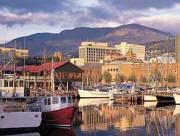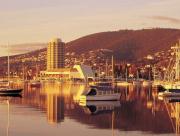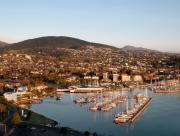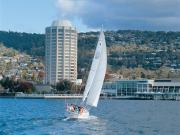Hobart Region Tasmania
Tasmania's capital sits below Mt Wellington on the shores of the Derwent River. It's a relaxed city with warm sandstone buildings, graceful old trees, heritage parks and gardens and spinnakers and clinking yachts on the water. To get a feel for the city head to Salamanca for coffee under striped sun umbrellas and take a walk through the 1830's warehouses that are now home to galleries, studios, restaurants and cafés.
The Salamanca Market on Saturdays is also a delight. It's also a city of fun, festivals and entertainment, from classical to contemporary, from pub bands to opera. The Derwent has shaped the city, which becomes evident when you hop on a river cruise or drive to the summit of Mount Wellington or Mt Nelson for spectacular views. River cruises offer morning tea, afternoon tea, lunch and dinner. Apart from the leisure yachts, the harbour is also a shelter for Antarctic supply vessels, catamarans, ocean racers, cray fishing boats, square-riggers, dinghies and kayaks. The docks are at their busiest in December and January (Sydney to Hobart Yacht Race and Hobart Summer Festival).
Things To Do in Hobart
· Sullivan's Cove, the waterfront area, is a delightful spot to begin exploring the city. Here you'll find Parliament House and the old sandstone warehouses of Salamanca Place.
· Nearby is the historic Theatre Royal, Australia's oldest continually operating theatre. For current shows, concerts and events you can call Centertainment Hobart on 6234 5998 (add area code if necessary - 03 within Australia or 613 international).
· There are many historic buildings on nearby Battery Point and a walk up Kelly's Steps from Salamanca Place is also rewarding. Arthur's Circus is a settlement of quaint and charming workers' cottages.
· The Royal Tasmanian Botanical Gardens is home to a variety of native and exotic plants.
· Other worthwhile parks and gardens include St David's Park, Fitzroy Gardens and Waterworks Reserve.
· There is an excellent collection of colonial art and natural history at the nearby Tasmanian Museum and Art Gallery. (Everything in Hobart is pretty much 'nearby' compared to most cities!) Also nearby - the Transport, Maritime and Allport museums and the Narryna Heritage Museum.
· The Old Hobart Gaol in Campbell Street will take you back in time, especially if you opt for the Ghost Tour.
· For a variety of fine restaurants, head to Salamanca Place or Elizabeth St in North Hobart.
· For those who like a flutter, Australia's first casino at Wrest Point may beckon.
For an interactive look at life in Australia in the last century, check out Time Warp House.
· You can also give the tastebuds a treat at the Cascade Brewery in South Hobart, the Cadbury chocolate factory in Claremont and the Island Produce fudge factory. Best to book ahead.
· To explore the Antarctic (without the hardship of going there!) visit the Antarctic Adventure Centre in Salamanca Place and the Australian Antarctic Division in Kingston.
· Day and evening coach tours are on hand for a quick and comfortable tour of the city and surrounds.
· There are also escorted Historic Hobart walks or you could pick up a self-guided walking map.
· For a birds eye view of the area scenic flight take off from Cambridge Airport for spectacular views of the Tasman Peninsula, East Coast, Port Davey and the Southwest wilderness.
· For golfers, there's a challenging but rewarding 18-hole public course at Rosny and the championship Royal Hobart is 20 minutes east of the city. Claremont is also a fine course, especially if you like the smell of chocolate that can waft from the nearby Cadbury factory.
· Bonorong Park Wildlife Centre in Brighton has Tasmanian devils, echidnas, wombats, koalas and other native fauna.
For the trivia buffs - marsupials are unique to Australia and kangaroos, koalas and Tasmanian devils are all marsupials, which means they have a pouch in which they carry their young. The koala and Tassie devil have an inverted pouch whereas the kangaroo has a pouch where the baby (joey) can poke its head up and admire the view.
Australia is also home to the world's only monotremes, the platypus and the echidna. Monotreme, basically, means 'one hole'. They have only one orifice for all bodily functions - waste removal and reproduction - which really isn't the greatest of designs. Nor is the Tasmanian devil when it comes to responsible child rearing. The female gives birth to between 30 and 40 tiny 'devils' but only has 4 nipples on offer, so it's survival of the fittest or quickest!
Richmond
Whether you are based in Hobart or heading elsewhere, you should include the historic town of Richmond in your itinerary. It's 25 kilometres and 100 years away from the city.
Richmond is full of fine Georgian architecture and has Australia's oldest preserved convict gaol, Australia's oldest bridge, Australia's oldest Catholic church, Old Hobart Town Model Village, and wonderful antique shops, art & craft galleries and tea rooms. Take time out for some freshly baked hot scones and soak in the atmosphere of the freestone cottages and imagine yourself as a convict in chains in the gaol's narrow cells - which may well have been considered luxurious compared to Port Arthur!
While some of the penal conditions were harsh, others weren't -depending on the time and who was running the place. When the original convicts arrived, they weren't imprisoned. They were assigned to work for someone as a 'servant'. The idea was that, if this person proved to be trustworthy and rehabilitated after a couple of years, he or she would be given a 'ticket of leave' allowing travel anywhere in the colony to work for wages or set up a business. Some well-behaved convicts were also granted plots of farming land. This had the authorities back in England in a bit of a quandary. On one hand, they were condoning a form of slavery. On the other, they were offering felons a far better lifestyle and future than most of the people had struggling in Dickensian London.
Rather than being a deterrent, crime was becoming the ticket to freedom. In 1838 the House of Commons decided that all transported prisoners would start their sentences working in gangs and living in barracks. Throw a breakdown in communication between England and Australia and a couple of harsh Governors and the result was an extremely unpleasant time for many of the convicts. Later, the assigning of convicts as servants was reintroduced, which pleased farmers looking for cheap labour and, in 1858, transportation to Eastern Australia ceased, primarily because people were queuing up to get on a boat, especially as gold had just been discovered in Victoria.





